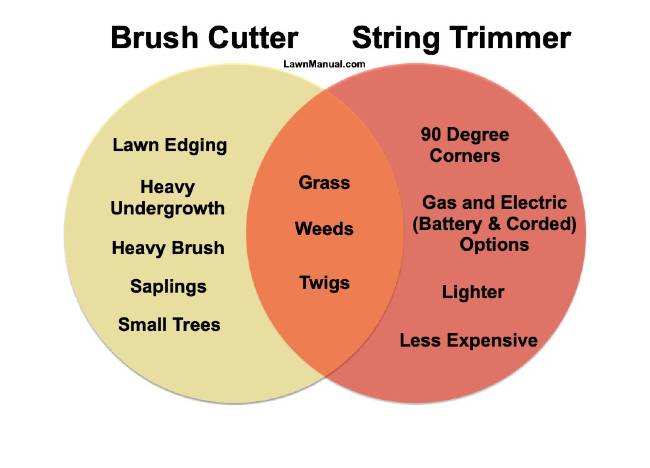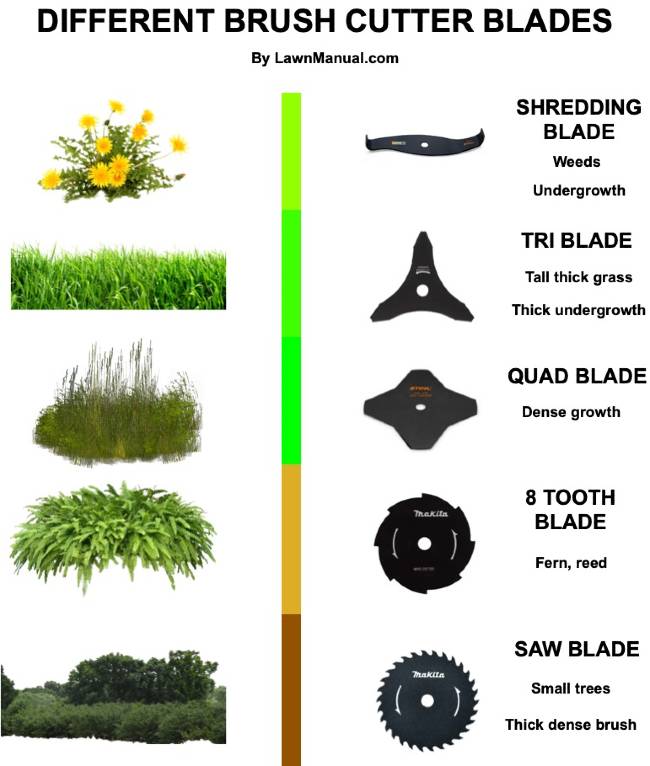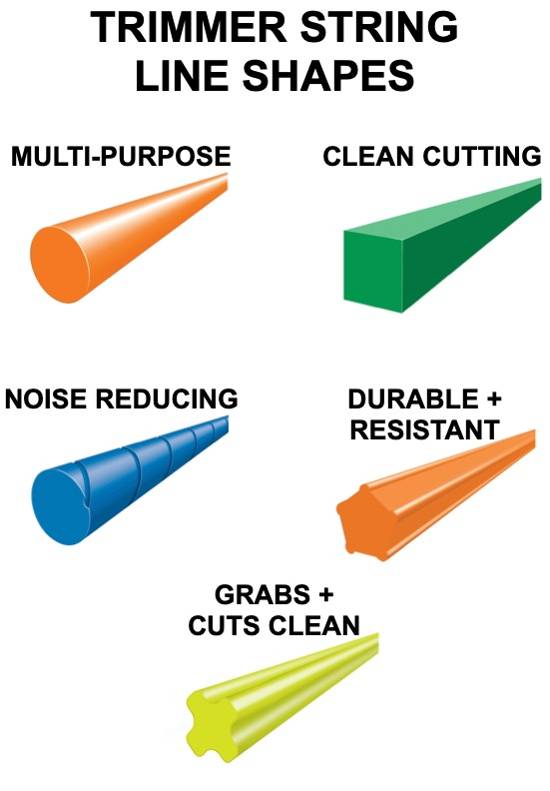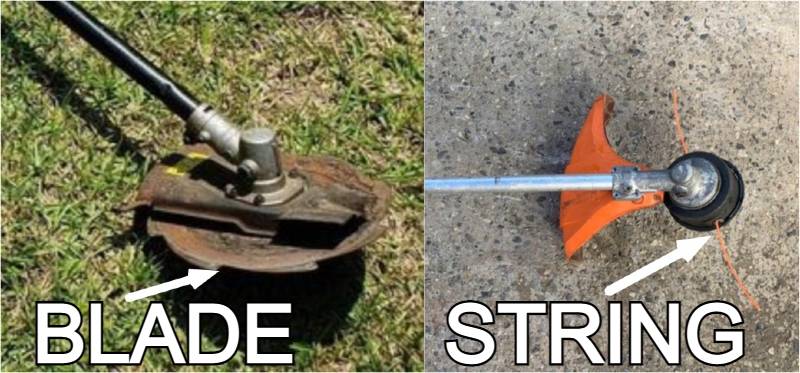A grass trimmer with a blade is called a brushcutter.
It is also commonly called:
- Brush trimmer
- Brush saw
- Clearing saw
Here are the pros and cons of a brush cutter (grass trimmer using blades):
- Pros: Different blade options for different brush density and thickness. Can cut through 2-inch trees and all matter of thinner shrub and undergrowth. Make quick work of thick grass, weeds, reed and fern. Powerful motor so you have the option of attaching a string spool for typical grass trimming with a string.
- Cons: Bigger small engine and sturdier build means heavier and harder to to do work all day without getting tired. More expensive out the box. More safety concerns with the blade compared to the string shooting rock and brush back at you. Replacement blades are more expensive than replacement string.
A grass trimmer with a string is called a string trimmer.
It is also commonly called:
- Weed eater
- Weed wacker
- Whipper snipper
- Line trimmer
- Strimmer
Here are the pros and cons of a string trimmer (grass trimmer using string):
- Pros: Easy to use because it is light and the string cuts through grass without shooting it up at your face. More affordable out of the box. Much better than the blade getting close to your house and garden edging without doing damage.
- Cons: Won’t cut through tougher brush and undergrowth. You will only want to use with long thick grass, weeds and small twig size branches and undergrowth. Many model string trimmer won’t have enough power for a blade attachment so it is not a 2-in-1 tool.
Brush Cutter vs. String Trimmer
Both types of grass trimmers do the job when it comes to grass, weeds and twigs.
But the brush cutter blade is what you’ll need for saplings, heavy brush and things like blackberry bushes and similar heavy undergrowth.
String trimmer string/line can do the job when it is grass (even heavy tall grass), weeds and small branches… But their main advantage is they are lighter and more affordable for homeowners.
Check out this VENN diagram we made to compare brush cutter (blades) vs string trimmer (strings):

Let’s take a deeper dive into the differences between a grass trimmer using blades (brush cutter) vs. one using a string or line (string trimmer).
What is a Brushcutter?
A brushcutter is a heavy duty grass trimmer that uses a blade instead of string.
Compared to string trimmers it has a more powerful engine, sturdier build and costs more.
When you look at the most popular brush cutter brands: Stihl, Husqvarna and ECHO – you see a trend in engine size, power, total brush cutter weight and cost.
Here are the specs of typical gas powered brushcutters:
- Engine displacement: 27cc to 42cc
- Engine power: 1.2 hp to 2.7 hp
- Brush cutter weight: 10 lbs to 17 lbs
- Cost: $400 to $1,000
Can you get battery powered brush cutters?
Yes.
- ECHO has 5 battery powered brushcutters.
- STIHL has 10 battery powered options.
- Husqvarna has 2 battery brushcutters.
- EGO Power+ has 1 option.
What is a String Trimmer?
A string trimmer is a grass trimmer that uses a string line instead of a blade to cut medium to high dense grass and weeds in hard to mow areas.
They are usually less heavy duty than a brush cutter and more enjoyable to use for longer periods given their lower weight and size.
Battery powered electric string trimmers made by Stihl, EGO and Ryobi
Here are the specs of regular gas string trimmers:
- Engine displacement: 27cc
- Engine power: 0.8 hp to 1 hp
- String trimmer weight: 9 lbs to 12 lbs
- Cost: $100 to $400
Battery powered string trimmers
Because of the lower power requirement battery string trimmers are common. The battery can power the string trimmer for 30 – 90 mins depending on battery capacity. They have enough power to get through long grass and weeds with ease.
Corded electric string trimmers
Although the electric cord is annoying corded electric string trimmers are popular because they have all the advantages of electric (no fumes, less noise, lighter, no maintenance) but without the extra cost of the battery.
What is a Brushcutter Used For?
Bladed grass trimmers are used for tough bushes, brush, saplings and anything your string can’t handle and you don’t feel like pulling your chainsaw out for.
Check out this video to see how easily this brushcutter gets through thick bush:
Brush cutter safety
You will need to wear personal protective equipment with using a grass trimmer with blades:
- Enclosed shoes preferable steel toe
- Long pants
- Face shield and rated safety glasses
- Hearing protection
- Long sleeve shirt with reflective stripes
- Preferably you wear gloves.
What is a String Trimmer Used For?
String trimmers are used in the garden to keep the edges tidy and trimmed.
Check out this video how you can use your string trimmer to get your garden looking 10/10:
Can You Use Blades on a String Trimmer?
Sometimes.
The more powerful string trimmers allow you to attach a shaft/bladed combo so you can turn your weed eater into a brush cutter.
However, 80% of string trimmer models don’t have the power to provide enough torque to the heavier blade. Be sure to check the model features or ask your local lawn equipment dealer.
Can You Use String Line on a Brush Cutter?
Almost all brush cutters have the option to buy an attachment string spool. Since a brush cutter has more power it can easily handle and string thickness or spool style you put on it.
What Are The Different Blades You Can Use on Brushcutter?
Depending on the job at hand you can switch the blade on more powerful grass trimmers so you can go from cutting down 2″ diameter trees with a 120 tooth saw blade to trimming grass and weeds with a tri blade (3 tooth).
Check out the different blades and their uses in the below chart:

What Are The Pros and Cons of Different String Thickness, String Shape and String Materials
String Thickness
The thicker the string the thicker the brush and weeds it can cut through.
Here are the 5 most common line thicknesses you can get:
- .130″ – Thickest for strongest cutting/trimming ability but also requires more torque
- .105″ – This thick trimmer line is popular for thicker brush and weeds.
- .095″ – The sweet spot in the middle with great clean cuts but enough thickness for wear resistance.
- .080″ – A decent sweet spot of wear resistance, cut quality and ability to get through tough grass.
- .065″ – The smaller the line the cleaner the cut. But you will also go through the most of this thickness as it wears down faster.
String Shape
The Stihl lineup of trimmer line shapes are in the chart below. We must say that we prefer the round and square line.

String material
Monofilament nylon is by far the most common string line material used in string trimmers. It is the exact material of fishing line – just thicker and harder to coil up like in a fishing reel.
Curved Shaft vs. Straight Shaft
A matter of preference and what jobs you are tackling.
Straight shaft is more popular.
The Bottom Line
Blades are more robust and cut through thicker vegetation than string.
Brushcutters are more powerful (horsepower) to rotate the blade at speed and are therefore more expensive and heavier.
String trimmer are more popular because they are lighter, more affordable and most people don’t require their grass trimmer to cut 2″ trees.
If you would prefer to just use a lawn mower then check out our list of the 7 best lawn mowers for most people.
Sources:
- String trimmer line thickness. LawnSite.com.
- Trimers & Brushcutters. StihlUSA.com.
- Trimmers & Brushcutters. EchoTools.com.
- Line Trimmers & Brushcutters. EgoPowerPlus.com.

